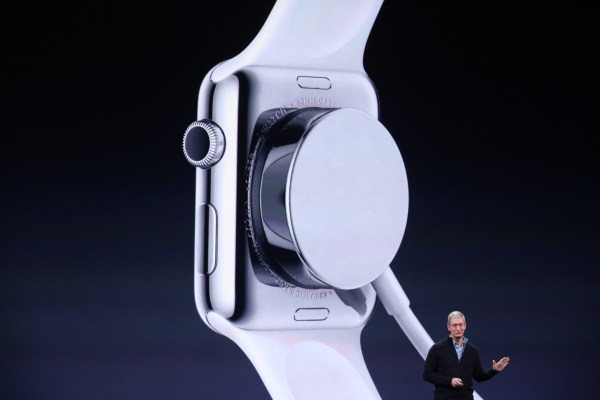The Apple Watch got its grand unveiling yesterday. You can read our round-up of details from Apple’s event here. But as tech watchers chewed over the price-tag for the latest luxury gizmo to be born in Cupertino talk turned to obsolescence.
The Apple Watch starts at $349 for the sports watch and rises to a cool $17,000 for top-of-the-luxury-line 18-karat gold Edition. But who wants to shell out thousands for an add-on electronic device that’s likely going to be obsolete in two years?
Well, when it comes to the battery at least, owners of Apple Watch will be able to extend its lifespan. An Apple spokesman confirmed to TechCrunch the “battery is replaceable”. Albeit, it’s not clear how much it will cost to send in your wearable to Apple to get it returned with a new cell in place. Update: We understand the lifecycle of the battery is around three years.
The other potential obsolescence issue relates to the processor. It’s not clear whether Apple will offer any kind of CPU and/or RAM upgrade to existing owners. At the time of writing Apple had not responded to our request for clarification. We’ll update this post with any additional details. (Given the varying price-points, it’s possible Apple might offer certain types of internal upgrades to owners of only the more premium Apple Watches — who’ve shelled out the most in the first place.)
Even so, battery longevity is arguably more of a pressing issue, given that the power demands for such a lightweight wearable are constrained by usage limitations. The use-cases Apple is sketching are mostly about allowing the owner to reduce their exposure to digital noise via curated notifications and selective communications.
How much more processing clout you need to power that is up for debate, especially given that the Watch requires its wearers also own an iPhone pocket computer — which they likely will continue to upgrade, per carrier cycles.
The fitness angle for Apple’s wearable is probably going to be the most power thirsty use-case, based on utilizing more sensor tech, so it’s likely no accident the sports watch version is the cheapest — and thus the least painful to upgrade entirely. Buyers of the $17,000 watch clearly aren’t going to be interested in sweating all over their luxury tech.
One thing is amply clear: the daily battery life of the Watch will be a pain-point. Apple is claiming it will be good for “all-day mixed usage” — albeit that boils down to just “90 time checks, 90 notifications, 45 minutes of app use, and a 30-minute workout with music playback from Apple Watch via Bluetooth over the course of 18 hours”.
If you’re using the Watch for a workout with the heart rate sensor turned on usage drops to up to seven hours. Music playback squeezes its battery life to up to 6.5 hours. And taking phone calls will limit usage to up to three hours.
If you’re happy just using your expensive smartwatch as a timepiece the battery can apparently last up to two days — which still sounds laughably brief to anyone who wears a non-smartwatch. And if you’re used to owning automatic mechanical timepieces stamped with a luxury brand you are absolutely not used to having to charge your high class wrist-wear every other day.
